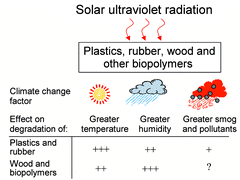The outdoor service life of common plastic materials is limited by their susceptibility to solar ultraviolet radiation. Of the solar wavelengths the UV-B component is particularly efficient in bringing about photodamage in synthetic and naturally occurring materials. This is particularly true of plastics, rubber and wood used in the building and agricultural industries. Any depletion in the stratospheric ozone layer and resulting increase in the UV-B component of terrestrial sunlight will therefore tend to decrease the service life of these materials. The extent to which the service life is reduced is, however, difficult to estimate as it depends on several factors. These include the chemical nature of the material, the additives it contains, the type and the amount of light-stabilizers (or protective coatings) used, and the amount of solar exposure it receives. Concomitant climate change is likely to increase the ambient temperature and humidity in some of the same regions likely to receive increased UV-B radiation. These factors, particularly higher temperatures, are also well known to accelerate the rate of photodegradation of materials, and may therefore further limit the service life of materials in these regions. To reliably assess the damage to materials as a consequence of ozone layer depletion, the wavelength sensitivity of the degradation process, dose-response relationships for the material and the effectiveness of available stabilizers need to be quantified. The data needed for the purpose are not readily available at this time for most of the commonly used plastics or wood materials. Wavelength sensitivity of a number of common plastic materials and natural biopolymers are available and generally show the damage (per photon) to decrease exponentially with the wavelength. Despite the relatively higher fraction of UV-A in sunlight, the UV-B content is responsible for a significant part of light-induced damage of materials.
The primary approach to mitigation relies on the effectiveness of the existing light stabilizers (such as hindered amine light stabilizers, HALS) used in plastics exposed to harsh solar UV conditions coupled with climate change factors. In developing advanced light-stabilizer technologies, more light-resistant grades of common plastics, or surface protection technologies for wood, the harsh weathering environment created by the simultaneous action of increased UV-B levels due to ozone depletion as well as the relevant climate change factors need to be taken into consideration. Recent literature includes several studies on synergism of HALS-based stabilizers, stabilizer effectiveness in the new m-polyolefins and elucidation of the mechanism of stabilization afforded by titania pigment in vinyl plastics.


 Please wait while we load your content...
Please wait while we load your content...